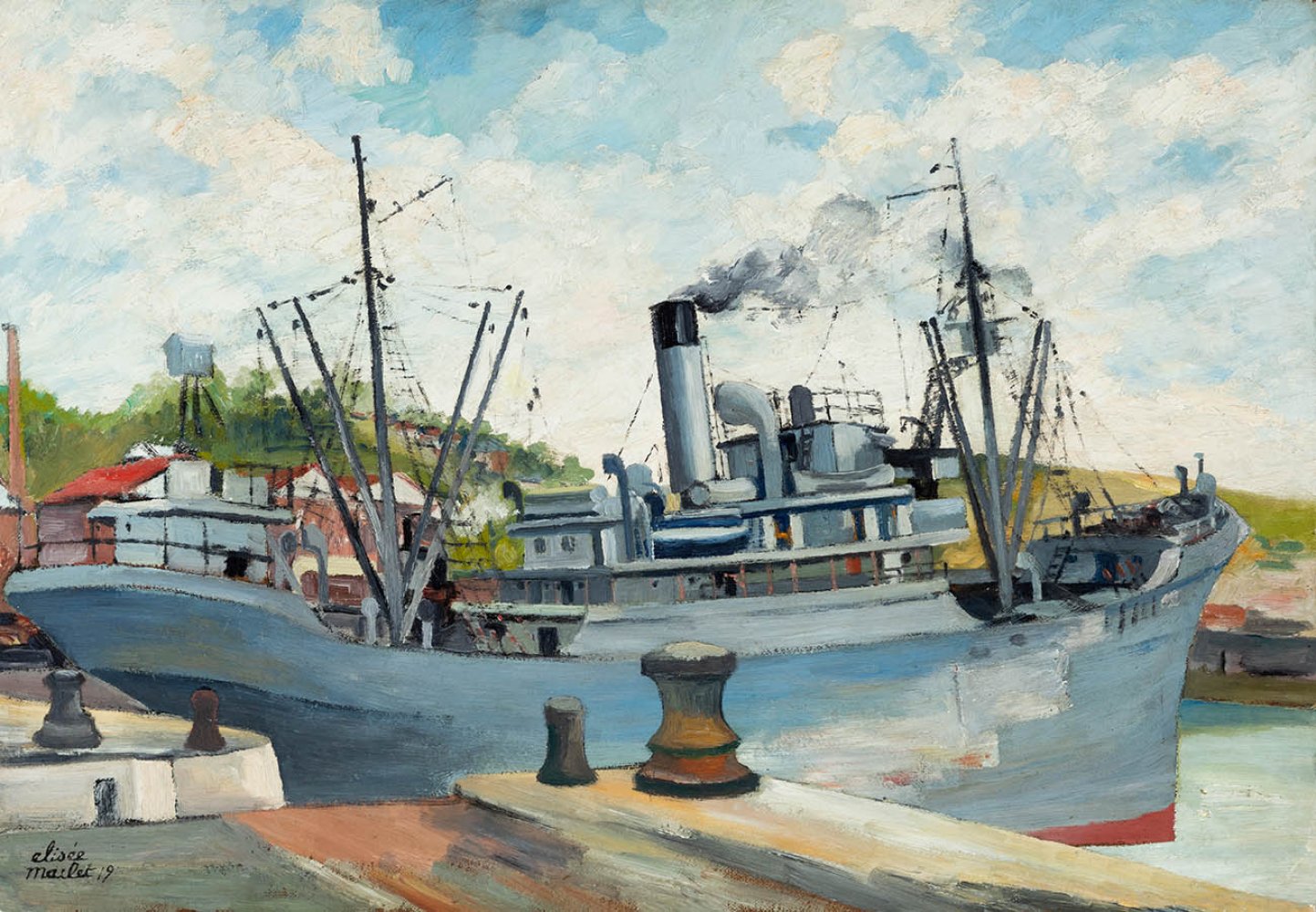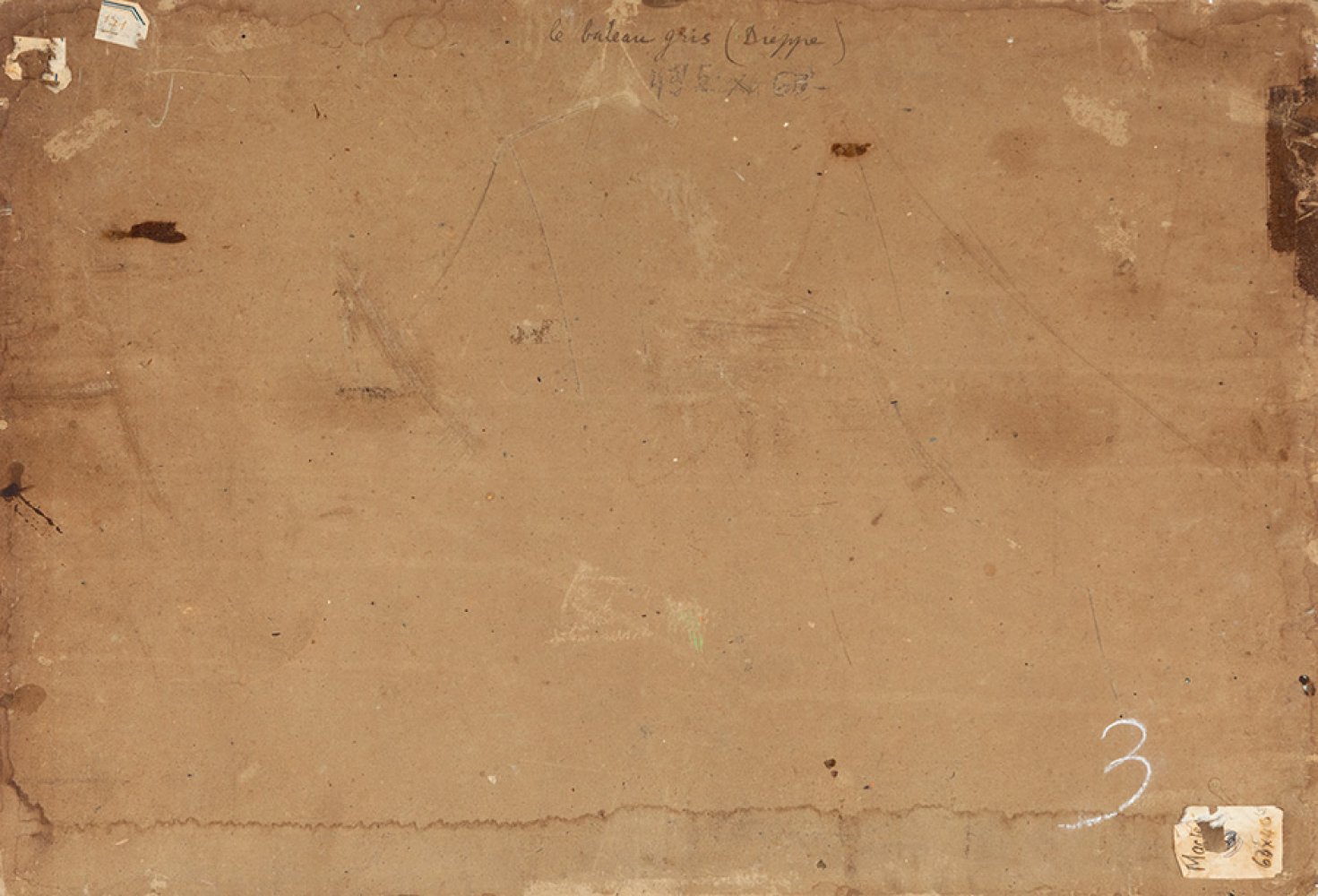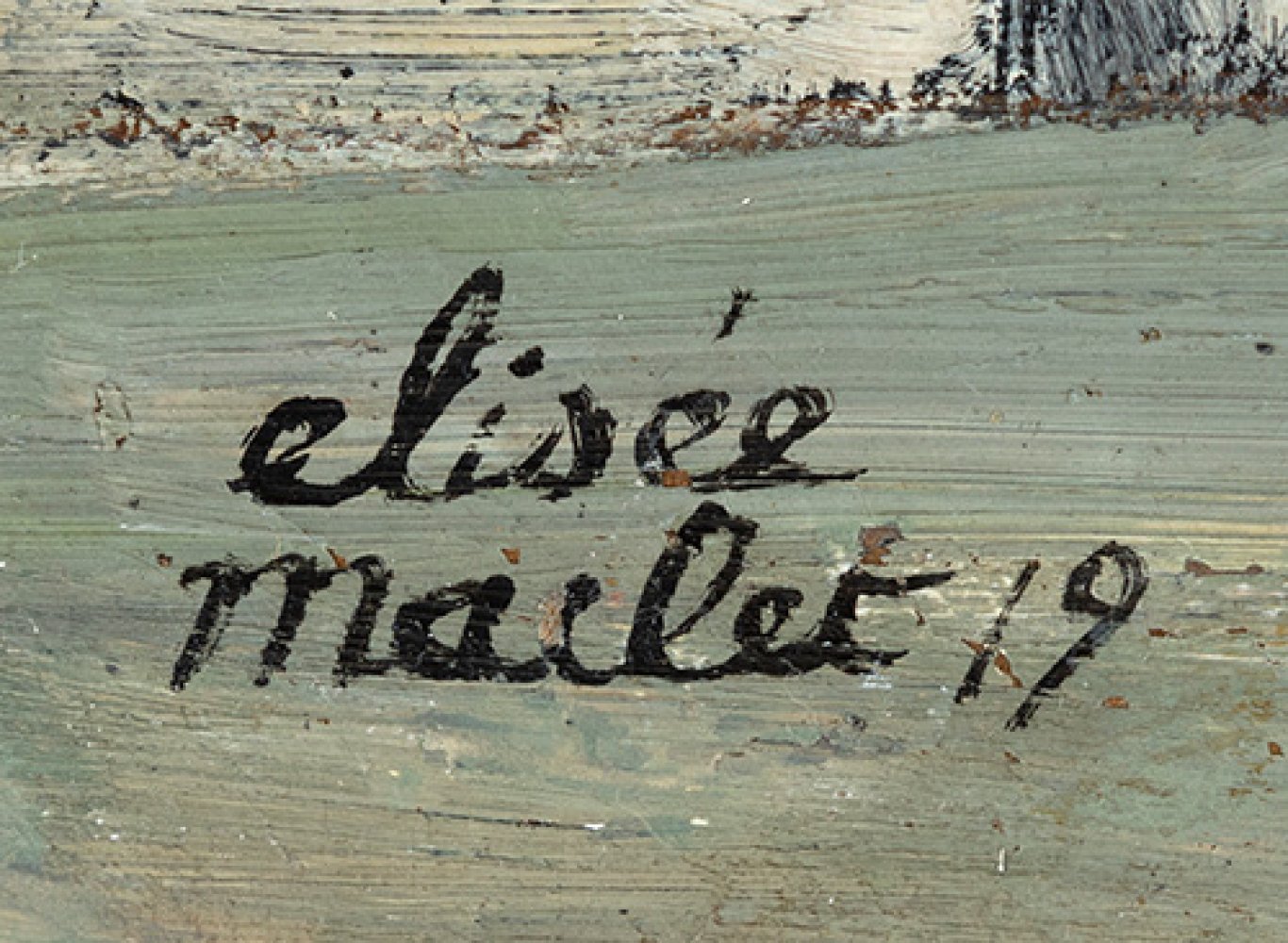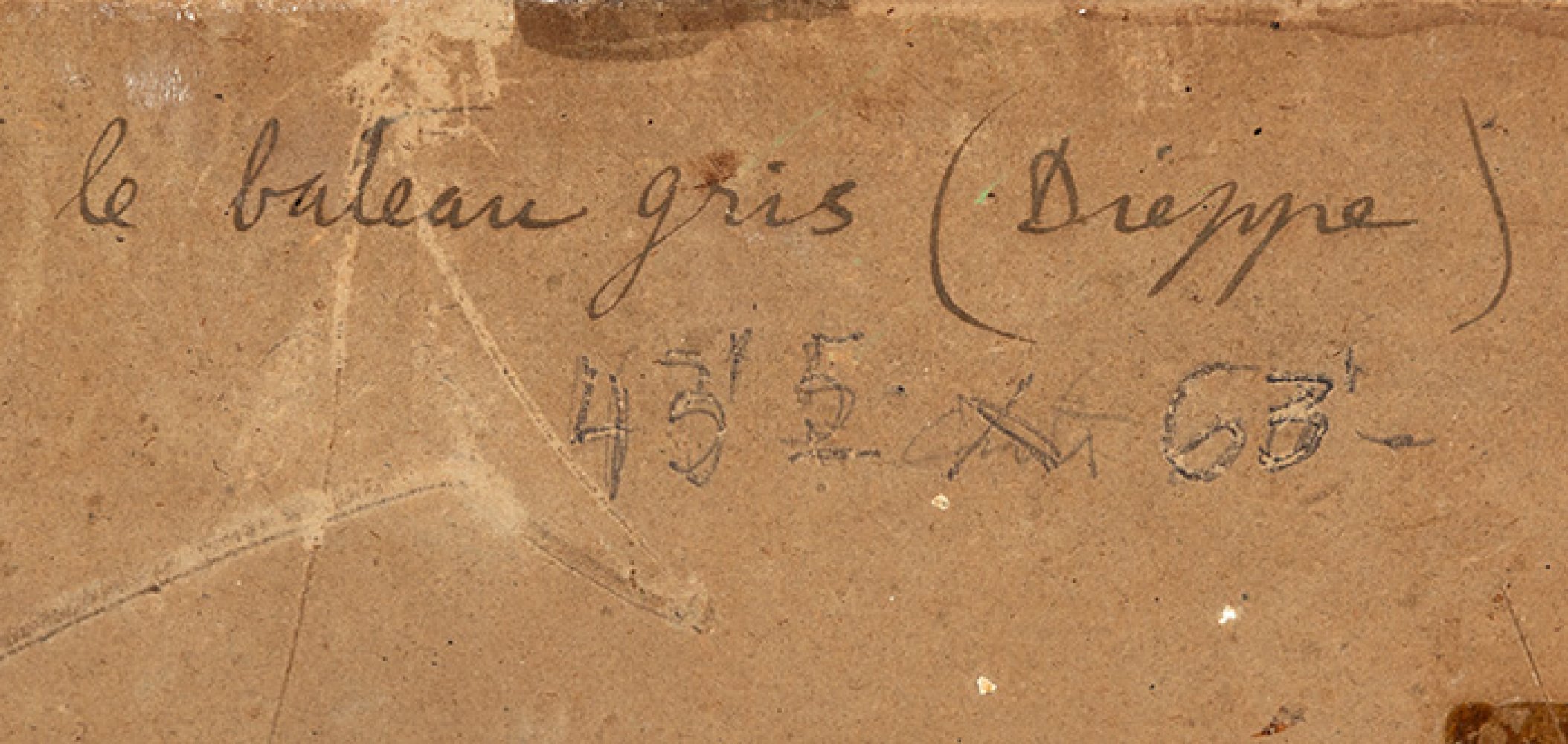40
ELISÉE MACLET (Lyons-en-Santerre, 1881 - Paris 1962)."Le bateau gris (The Grey Boat), Dieppe, 1919.
1/4
Description
ELISÉE MACLET (Lyons-en-Santerre, 1881 - Paris 1962).
"Le bateau gris (The Grey Boat), Dieppe, 1919.
Oil on cardboard.
Signed and dated in the lower left corner. Titled and located on the back.
Size: 43 x 63 cm.
Elisée Maclet enjoyed a hectic personal life which led him to live in many places in France. The work in question, painted during his time in the French region of Normandy, reflects the lyricism of the northern landscape, through the use of deep, intense and bold colours. At the invitation of his friend Francis Carco, in 1918 Maclet moved to the coastal town of Dieppe, where, for a year, he painted numerous seascapes and coastal views of great beauty and exceptionality.
Élisée Maclet initially developed a "primitivist" style of painting which earned him a place among the "naïff" painters of the beginning of the century. In 1906, Maclet moved to Paris. There he settled in the Montmartre district and produced most of the landscape and street scenes for which he is best known. Maclet's Parisian scenes were successful, especially after the First World War, and he maintained this success for the rest of his career due to the unique sensibility and original techniques he demonstrated in his works. Many of the French writers appreciated his paintings and often wrote about him, including Max Jacob, Sidonie Gabrielle Colette and Francis Carco. From 1918 to 1919, Maclet painted seascapes in Dieppe, living in a house that Carco lent him. He returned to Montmartre in 1919. In 1920, the art dealer Dosbourg bought some of his first Montmartre scenes. He lived in Arles from 1923 to 1928, where he painted many remarkable landscapes expressing his enchantment with nature and Mediterranean culture, some of which sometimes recall Matisse. In 1928, Maclet received his first major solo exhibition, held at the Gallerie Barreiro in Paris, where more than 50 of his works were exhibited. At the end of the year, he left mainland France on a painting excursion to the island of Corsica. He then went to Brittany, where he lived and worked in 1929 and 1930. In 1957 the first major retrospective of Maclet's work was held at the Nicolas Poussin Gallery in Paris, and in 1960 the same gallery presented his work in its exhibition "Paintings of the 20th Century"; another major retrospective took place in 1961, at the Thibaut Gallery in New York City. In the period following his international breakthrough, Maclet was the subject of numerous magazine articles and, in time, several public collections in Europe and America acquired examples of his work, including museums in Chicago, Bremen, Geneva, Sweden, Norway and Monte. After his death in 1962, Maclet posthumously received several international tributes, including solo exhibitions in Paris, Germany and Venezuela, as well as a major exhibition at the Vestart Galleries in New York City in 1969. In 2011, the National Gallery of Bermuda mounted a solo exhibition of his work. Today, his work is represented in a number of important international collections, both public and private, with many of his paintings held by the Musée d'Art Moderne in Paris.
"Le bateau gris (The Grey Boat), Dieppe, 1919.
Oil on cardboard.
Signed and dated in the lower left corner. Titled and located on the back.
Size: 43 x 63 cm.
Elisée Maclet enjoyed a hectic personal life which led him to live in many places in France. The work in question, painted during his time in the French region of Normandy, reflects the lyricism of the northern landscape, through the use of deep, intense and bold colours. At the invitation of his friend Francis Carco, in 1918 Maclet moved to the coastal town of Dieppe, where, for a year, he painted numerous seascapes and coastal views of great beauty and exceptionality.
Élisée Maclet initially developed a "primitivist" style of painting which earned him a place among the "naïff" painters of the beginning of the century. In 1906, Maclet moved to Paris. There he settled in the Montmartre district and produced most of the landscape and street scenes for which he is best known. Maclet's Parisian scenes were successful, especially after the First World War, and he maintained this success for the rest of his career due to the unique sensibility and original techniques he demonstrated in his works. Many of the French writers appreciated his paintings and often wrote about him, including Max Jacob, Sidonie Gabrielle Colette and Francis Carco. From 1918 to 1919, Maclet painted seascapes in Dieppe, living in a house that Carco lent him. He returned to Montmartre in 1919. In 1920, the art dealer Dosbourg bought some of his first Montmartre scenes. He lived in Arles from 1923 to 1928, where he painted many remarkable landscapes expressing his enchantment with nature and Mediterranean culture, some of which sometimes recall Matisse. In 1928, Maclet received his first major solo exhibition, held at the Gallerie Barreiro in Paris, where more than 50 of his works were exhibited. At the end of the year, he left mainland France on a painting excursion to the island of Corsica. He then went to Brittany, where he lived and worked in 1929 and 1930. In 1957 the first major retrospective of Maclet's work was held at the Nicolas Poussin Gallery in Paris, and in 1960 the same gallery presented his work in its exhibition "Paintings of the 20th Century"; another major retrospective took place in 1961, at the Thibaut Gallery in New York City. In the period following his international breakthrough, Maclet was the subject of numerous magazine articles and, in time, several public collections in Europe and America acquired examples of his work, including museums in Chicago, Bremen, Geneva, Sweden, Norway and Monte. After his death in 1962, Maclet posthumously received several international tributes, including solo exhibitions in Paris, Germany and Venezuela, as well as a major exhibition at the Vestart Galleries in New York City in 1969. In 2011, the National Gallery of Bermuda mounted a solo exhibition of his work. Today, his work is represented in a number of important international collections, both public and private, with many of his paintings held by the Musée d'Art Moderne in Paris.
Auction Details
Shipping
T&Cs & Important Info
Ask seller a question
ELISÉE MACLET (Lyons-en-Santerre, 1881 - Paris 1962).
"Le bateau gris (The Grey Boat), Dieppe, 1919.
Oil on cardboard.
Signed and dated in the lower left corner. Titled and located on the back.
Size: 43 x 63 cm.
Elisée Maclet enjoyed a hectic personal life which led him to live in many places in France. The work in question, painted during his time in the French region of Normandy, reflects the lyricism of the northern landscape, through the use of deep, intense and bold colours. At the invitation of his friend Francis Carco, in 1918 Maclet moved to the coastal town of Dieppe, where, for a year, he painted numerous seascapes and coastal views of great beauty and exceptionality.
Élisée Maclet initially developed a "primitivist" style of painting which earned him a place among the "naïff" painters of the beginning of the century. In 1906, Maclet moved to Paris. There he settled in the Montmartre district and produced most of the landscape and street scenes for which he is best known. Maclet's Parisian scenes were successful, especially after the First World War, and he maintained this success for the rest of his career due to the unique sensibility and original techniques he demonstrated in his works. Many of the French writers appreciated his paintings and often wrote about him, including Max Jacob, Sidonie Gabrielle Colette and Francis Carco. From 1918 to 1919, Maclet painted seascapes in Dieppe, living in a house that Carco lent him. He returned to Montmartre in 1919. In 1920, the art dealer Dosbourg bought some of his first Montmartre scenes. He lived in Arles from 1923 to 1928, where he painted many remarkable landscapes expressing his enchantment with nature and Mediterranean culture, some of which sometimes recall Matisse. In 1928, Maclet received his first major solo exhibition, held at the Gallerie Barreiro in Paris, where more than 50 of his works were exhibited. At the end of the year, he left mainland France on a painting excursion to the island of Corsica. He then went to Brittany, where he lived and worked in 1929 and 1930. In 1957 the first major retrospective of Maclet's work was held at the Nicolas Poussin Gallery in Paris, and in 1960 the same gallery presented his work in its exhibition "Paintings of the 20th Century"; another major retrospective took place in 1961, at the Thibaut Gallery in New York City. In the period following his international breakthrough, Maclet was the subject of numerous magazine articles and, in time, several public collections in Europe and America acquired examples of his work, including museums in Chicago, Bremen, Geneva, Sweden, Norway and Monte. After his death in 1962, Maclet posthumously received several international tributes, including solo exhibitions in Paris, Germany and Venezuela, as well as a major exhibition at the Vestart Galleries in New York City in 1969. In 2011, the National Gallery of Bermuda mounted a solo exhibition of his work. Today, his work is represented in a number of important international collections, both public and private, with many of his paintings held by the Musée d'Art Moderne in Paris.
"Le bateau gris (The Grey Boat), Dieppe, 1919.
Oil on cardboard.
Signed and dated in the lower left corner. Titled and located on the back.
Size: 43 x 63 cm.
Elisée Maclet enjoyed a hectic personal life which led him to live in many places in France. The work in question, painted during his time in the French region of Normandy, reflects the lyricism of the northern landscape, through the use of deep, intense and bold colours. At the invitation of his friend Francis Carco, in 1918 Maclet moved to the coastal town of Dieppe, where, for a year, he painted numerous seascapes and coastal views of great beauty and exceptionality.
Élisée Maclet initially developed a "primitivist" style of painting which earned him a place among the "naïff" painters of the beginning of the century. In 1906, Maclet moved to Paris. There he settled in the Montmartre district and produced most of the landscape and street scenes for which he is best known. Maclet's Parisian scenes were successful, especially after the First World War, and he maintained this success for the rest of his career due to the unique sensibility and original techniques he demonstrated in his works. Many of the French writers appreciated his paintings and often wrote about him, including Max Jacob, Sidonie Gabrielle Colette and Francis Carco. From 1918 to 1919, Maclet painted seascapes in Dieppe, living in a house that Carco lent him. He returned to Montmartre in 1919. In 1920, the art dealer Dosbourg bought some of his first Montmartre scenes. He lived in Arles from 1923 to 1928, where he painted many remarkable landscapes expressing his enchantment with nature and Mediterranean culture, some of which sometimes recall Matisse. In 1928, Maclet received his first major solo exhibition, held at the Gallerie Barreiro in Paris, where more than 50 of his works were exhibited. At the end of the year, he left mainland France on a painting excursion to the island of Corsica. He then went to Brittany, where he lived and worked in 1929 and 1930. In 1957 the first major retrospective of Maclet's work was held at the Nicolas Poussin Gallery in Paris, and in 1960 the same gallery presented his work in its exhibition "Paintings of the 20th Century"; another major retrospective took place in 1961, at the Thibaut Gallery in New York City. In the period following his international breakthrough, Maclet was the subject of numerous magazine articles and, in time, several public collections in Europe and America acquired examples of his work, including museums in Chicago, Bremen, Geneva, Sweden, Norway and Monte. After his death in 1962, Maclet posthumously received several international tributes, including solo exhibitions in Paris, Germany and Venezuela, as well as a major exhibition at the Vestart Galleries in New York City in 1969. In 2011, the National Gallery of Bermuda mounted a solo exhibition of his work. Today, his work is represented in a number of important international collections, both public and private, with many of his paintings held by the Musée d'Art Moderne in Paris.
31st August -19th & 20th Century Arts
Sale Date(s)
Venue Address
Aragón 346, Barcelona
Calle Velázquez 7, Madrid
Carrer de Cirilo Amorós 55, Valencia
Barcelona
08009
Spain
General delivery information available from the auctioneer
Setdart offers Worldwide shipping
PICK UP IN ROOM: You can come and pick up your lots in our offices (Barcelona, Madrid or Valencia). At the moment of the withdrawal, you will be able to accept the current conditions of the lot by means of a document that you will sign.
YOU CAN SEND ANOTHER PERSON TO PICK UP: This person must present a signed authorization that you can find in our web page by accessing from BUY AT SETDART- LOGISTICS-DOWNLOAD AUTHORIZATION DOCUMENT. You can also send an e-mail with the requested data in AUTHORIZATION DOCUMENT to admin@setdart.com
Important Information
25% buyer´s premium
21% buyer´s premium at www.setdart.com












